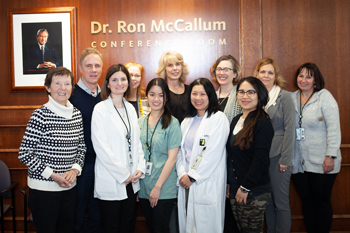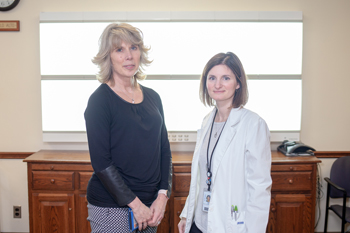Medical Imaging leading a new way of developing student and resident learners

By Emily Dawson

The new Medical Imaging (MI) Education Committee at St. Michael’s Hospital. (Photos by Yuri Markarov)
The new Medical Imaging (MI) Education Committee at St. Michael’s Hospital is helping to ensure the next generation of clinicians is well equipped to provide the highest quality patient care.
Understanding that an investment in teaching today will lead to better patient outcomes in the future, this committee was created to build MI’s capacity to accommodate more students and create a uniform experience for learners.
Carolyn Trottier, operations leader, and Cara Mazur, medical technical specialist, work in Ultrasound and are the first elected co-chairs of the MI Education Committee.
“There was a desire from the MI disciplines to bring in more students,” said Trottier. “The challenge lay in our ability to balance high patient volumes with a positive learner experience, without compromising care.”
Trottier and Mazur saw an opportunity to standardize the student onboarding and placement outcomes, and to improve communication between staff, preceptors, and learners.
“In Ultrasound, we’d been informally applying these principles over the last few years and seeing great results. We saw the opportunity to enable greater efficiency and a robust student experience in other MI fields,” said Mazur.
Emily Leung, a former Ultrasound student, had a positive onboarding experience. “Everything from protocols to small details on how things worked in the department were clearly explained in the first week,” said Leung.

Carolyn Trottier (left), operations leader, and Cara Mazur, medical technical specialist, work in Ultrasound and are the first elected co-chairs of the MI Education Committee.
“Besides learning to scan, there are other tasks sonographers do, such as maintaining the flow of patient scheduling, reviewing previous exams and patient history, and working with patients to ensure their comfort and readiness for their appointment. These are done before and after each exam and they all play a role in the overall efficiency.
“This was a great teaching approach that helped ease the overwhelming feelings, and gave me structure and a sense of autonomy.”
Trottier and Mazur also acknowledge how open communication leads to clarity around goals and objectives and keeps students engaged in providing feedback on what’s working and where there’s room to improve.
“Students know that there’s a group of people looking after them. That’s really meaningful in our fast-paced environment, where students face so many interactions with staff, teachers and patients every day,” said Mazur.
“Communication between the preceptors made sure that everyone was on the same page and provided a group of mentors that I felt comfortable to approach when I needed guidance,” added Leung.
In addition to their work with learners, the MI Education Committee is also looking at ways to support preceptors. Consistency with education and communication approaches is essential to effective teaching.
“Learning from a group of preceptors is great because you get to learn and combine various techniques that work for you as a growing sonographer,” said Leung.
“However, consistency and repetition at the beginning of the term are crucial because every sonographer has their own style and protocol, so it’s best to work more frequently with a single preceptor to start.”
The future is bright for patients who will need medical imaging at St. Michael’s.
“Our goal is train our professionals to provide the highest quality patient care. The committee can measure its success when our learners enter their careers with confidence, a reliable toolkit, and an open, collaborative approach,” said Trottier.
“And if we can hire them at St. Michael’s when they graduate, we’ll be golden!”
About St. Michael’s Hospital
St. Michael’s Hospital provides compassionate care to all who enter its doors. The hospital also provides outstanding medical education to future health care professionals in more than 27 academic disciplines. Critical care and trauma, heart disease, neurosurgery, diabetes, cancer care, care of the homeless and global health are among the Hospital’s recognized areas of expertise. Through the Keenan Research Centre and the Li Ka Shing International Healthcare Education Centre, which make up the Li Ka Shing Knowledge Institute, research and education at St. Michael’s Hospital are recognized and make an impact around the world. Founded in 1892, the hospital is fully affiliated with the University of Toronto.
About Unity Health Toronto
Unity Health Toronto, comprised of Providence Healthcare, St. Joseph’s Health Centre and St. Michael’s Hospital, works to advance the health of everyone in our urban communities and beyond. Our health network serves patients, residents and clients across the full spectrum of care, spanning primary care, secondary community care, tertiary and quaternary care services to post-acute through rehabilitation, palliative care and long-term care, while investing in world-class research and education. For more information, visit www.unityhealth.to.
